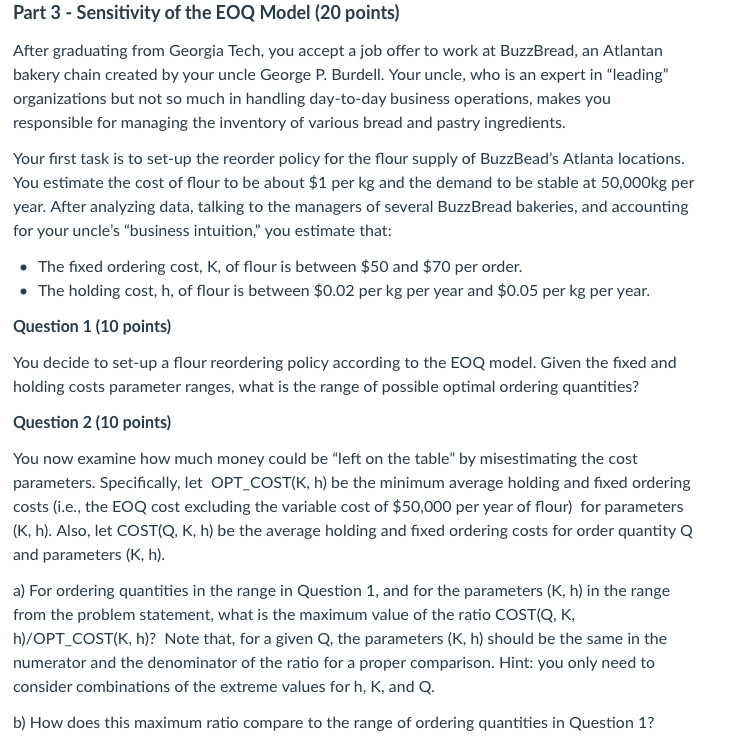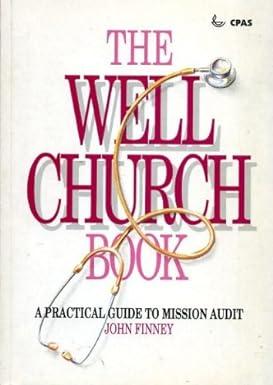
Part 3 - Sensitivity of the EOQ Model (20 points) After graduating from Georgia Tech, you accept a job offer to work at BuzzBread, an Atlantan bakery chain created by your uncle George P. Burdell. Your uncle, who is an expert in "leading" organizations but not so much in handling day-to-day business operations, makes you responsible for managing the inventory of various bread and pastry ingredients. Your first task is to set-up the reorder policy for the flour supply of BuzzBead's Atlanta locations. You estimate the cost of flour to be about $1 per kg and the demand to be stable at 50,000kg per year. After analyzing data, talking to the managers of several BuzzBread bakeries, and accounting for your uncle's "business intuition," you estimate that: The fixed ordering cost, K, of flour is between $50 and $70 per order. The holding cost, h, of flour is between $0.02 per kg per year and $0.05 per kg per year. Question 1 (10 points) You decide to set-up a flour reordering policy according to the EOQ model. Given the fixed and holding costs parameter ranges, what is the range of possible optimal ordering quantities? Question 2 (10 points) You now examine how much money could be left on the table by misestimating the cost parameters. Specifically, let OPT_COST(K, h) be the minimum average holding and fixed ordering costs (i.e., the EOQ cost excluding the variable cost of $50,000 per year of flour) for parameters (K, h). Also, let COSTQ, K, h) be the average holding and fixed ordering costs for order quantity Q and parameters (K, h). a) For ordering quantities in the range in Question 1, and for the parameters (K, h) in the range from the problem statement, what is the maximum value of the ratio COST(Q, K, h)/OPT_COST(K, h)? Note that, for a given Q, the parameters (K, h) should be the same in the numerator and the denominator of the ratio for a proper comparison. Hint: you only need to consider combinations of the extreme values for h, K, and Q. b) How does this maximum ratio compare to the range of ordering quantities in Question 1? Part 3 - Sensitivity of the EOQ Model (20 points) After graduating from Georgia Tech, you accept a job offer to work at BuzzBread, an Atlantan bakery chain created by your uncle George P. Burdell. Your uncle, who is an expert in "leading" organizations but not so much in handling day-to-day business operations, makes you responsible for managing the inventory of various bread and pastry ingredients. Your first task is to set-up the reorder policy for the flour supply of BuzzBead's Atlanta locations. You estimate the cost of flour to be about $1 per kg and the demand to be stable at 50,000kg per year. After analyzing data, talking to the managers of several BuzzBread bakeries, and accounting for your uncle's "business intuition," you estimate that: The fixed ordering cost, K, of flour is between $50 and $70 per order. The holding cost, h, of flour is between $0.02 per kg per year and $0.05 per kg per year. Question 1 (10 points) You decide to set-up a flour reordering policy according to the EOQ model. Given the fixed and holding costs parameter ranges, what is the range of possible optimal ordering quantities? Question 2 (10 points) You now examine how much money could be left on the table by misestimating the cost parameters. Specifically, let OPT_COST(K, h) be the minimum average holding and fixed ordering costs (i.e., the EOQ cost excluding the variable cost of $50,000 per year of flour) for parameters (K, h). Also, let COSTQ, K, h) be the average holding and fixed ordering costs for order quantity Q and parameters (K, h). a) For ordering quantities in the range in Question 1, and for the parameters (K, h) in the range from the problem statement, what is the maximum value of the ratio COST(Q, K, h)/OPT_COST(K, h)? Note that, for a given Q, the parameters (K, h) should be the same in the numerator and the denominator of the ratio for a proper comparison. Hint: you only need to consider combinations of the extreme values for h, K, and Q. b) How does this maximum ratio compare to the range of ordering quantities in Question 1







